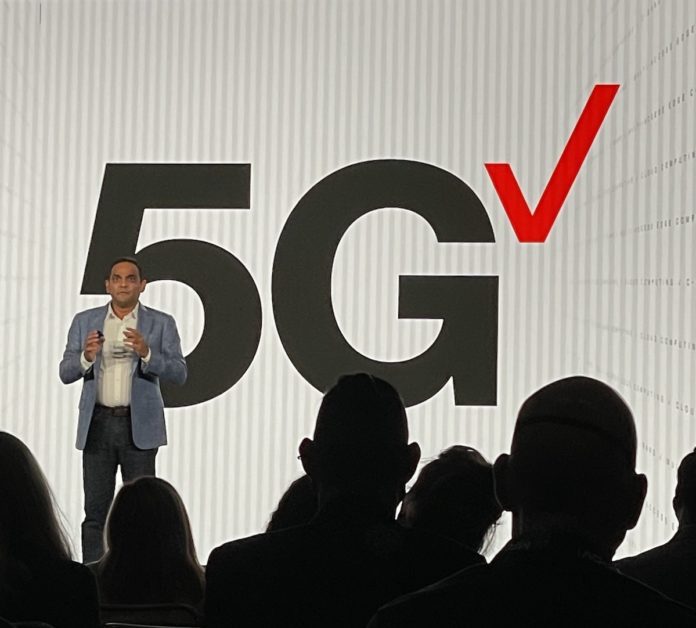As it continues to deploy its 5G network, with the latest boost from C-Band spectrum deployment increasing covered PoPs by 90 million, Verizon is following a “network-as-a-service” strategy that will open up new consumer and enterprise opportunities.
FWA for consumers and enterprises
For consumers, Verizon offers a 5G Home internet service that variably uses mmWave or C-Band spectrum. The goal is to become what Verizon Consumer Group Chief Revenue Officer Frank Boulben described as “a full connectivity provider for households and families. That means offering mobility services, as well as home broadband, whether it’s with Verizon Fios, 5G Home or 4G LTE internet. We have multiple brands covering the entire market.”
In its ongoing network upgrade and expansion, Verizon is realizing efficiencies from offering mobility and fixed wireless access services from the same sites. “Our 5G network can serve both mobility needs and home connectivity needs,” Boulben said. “Previously, we had one network for mobility and one for home. Now, consumers will be able to interact with just one brand and one company for all of their connectivity needs.”
On the enterprise side, the C-Band activation marked a major expansion of 5G Business, Verizon’s business-facing fixed wireless access offering. In a recent interview with RCR Wireless News, Verizon EVP and Business Group CEO Tami Erwin said 5G Business is all about “choice for customers. She noted that the FWA service, paired with existing national mobility distribution and leadership in every segment served, is a “natural extension” for business customers looking to bundle mobile and fixed broadband. “It really does give customers choice and value,” Erwin said. “The other thing we’re pretty excited about in our promotion at launch is…no price increase for 10 years.”
A two-pronged approach to MEC
Erwin said the C-Band activation is the “second phase of 5G” for Verizon. She said the combination of mmWave, mid-band and MEC results in a “21st century infrastructure.” In the context of 5G, gains in latency supported by the air interface need to be augmented with decentralized compute and storage; for latency-sensitive applications like precision robotics or augmented and virtual reality, piping data back to a centralized data center for processing offsets the reduction in latency made possible with the latest generation of cellular.
Verizon is all in on both public and private MEC and has a range of partnerships in place with the likes of AWS and Microsoft Azure as well as companies focused on applications. But its MEC infrastructure, live in 13 metro areas in its public form and on customers’ premises for private use, is part of a larger solution set, including its 5G network, both sub-6 GHz and mmWave, its private networks business, IoT devices and platform, and managed services.
Partnerships are key in Verizon’s larger strategy of delivering 5G-enabled enterprise solutions. In an interview ahead of Mobile World Congress Los Angeles, Verizon Business Chief Revenue Officer Sampath Sowmyanarayan said, “5G is all about the ecosystem. You cannot do it yourself. That’s been our focus on anything 5G-related.”
This partner-based approach has accelerated Verizon’s sales cycle, Sowmyanarayan said, explaining that depending on the customer, Verizon may take the lead, AWS may take the lead, etc…”It actually helps because we’re able to get to the right decision makers really fast. We can actually short circuit what would typically be a four- to six-month process.”
One example of how Verizon is using its MEC capabilities is to deliver near-real-time driver notifications to enhance road safety using sensor data. Working with Nissan North America’s Research and Advanced Engineering team, the companies demonstrated how sensor data from vehicles and surrounding infrastructure can be processed at the edge of Verizon’s wireless network and communicated back to the driver in near real time
The private, on-prem MEC solution is being used by logistics and supply chain specialist Ice Mobility for computer vision-assisted product packing. This flavor of MEC combines Verizon’s network with the Microsoft Azure Stack Edge.
IoT: ‘Low cost for massive deployment’
On stage at MWC Los Angeles, Sowmyanarayan announced that Verizon is committing further to IoT by enabling Verizon-certified IoT devices to connect to its 5G low-band spectrum network — branded as 5G Nationwide.
Additionally, the carrier debuted new intelligence capabilities that combine IoT network and device analytics on a single dashboard available for customer trials now via Verizon ThingSpace, the company’s IoT marketplace and management platform, which includes a bundle of existing IoT services, such as Intelligence Analytics Dashboard, SIM Secure, Device Diagnostics and Location Services.
As part of this IoT push, Verizon certified Quectel’s new BC660K-GL module, becoming the first carrier in the U.S. to enable the module on its nationwide narrowband IoT network. Powered by the Qualcomm 212 LTE IoT modem, the module supports multiple frequency bands with extremely low power consumption.
“Low cost for massive deployment is the name of the game here,” Sowmyanarayan said, explaining the module’s low cost of sub-$4 makes it an ideal choice for new narrowband-IoT device launches. Connectivity plans from Verizon will start at less than $1. In many ways, he continued, the modules can be compared to Wi-Fi access points, but with “much greater value proposition” because it’s “a turnkey cellular connectivity [solution] right out of the box.”
Soon, Sowmyanarayan said, Verizon-certified devices will also be compatible with the carrier’s Ultra Wideband network. With access to both networks, Verizon’s IoT platform will prove to be a powerful tool for enterprises as they look to gain data and insight from IoT devices and sensors. “As we continue to expand 5G Ultra Wideband to more and more places,” he said, “the opportunity for sensor densification explodes.”
For a more detailed look at how the telecoms sector is working to monetize 5G investments, register for free for the virtual 5G Monetization Forum on Feb. 15.

